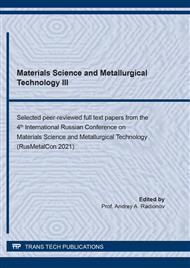[1]
V.V. Medvedev, S.N. Akhmedov, Evolution of the technology for the production of alumina from bauxites, in: J. Grandfield (Eds.), TMS Light Metals, 2014, pp.5-9.
DOI: 10.1002/9781118888438.ch1
Google Scholar
[2]
V.M. Sizyakov, V.Y. Bazhin, E.V. Sizyakova, Feasibility study of the use of nepheline-limestone charges instead of bauxite, Metallurgist. 59 (2016) 1135-1141.
DOI: 10.1007/s11015-016-0228-4
Google Scholar
[3]
J. Yang, J.N. Hryn, B.R. Davis, A. Roy, New opportunities for aluminum electrolysis with metal anodes in a low temperature electrolyte system, in: J. Grandfield (Eds.), TMS Light Metals 2004, pp.321-326.
Google Scholar
[4]
E.A. Yanko, The Anodes of Aluminum Electrolyzers, Ore and Metals, Moscow, (2001).
Google Scholar
[5]
A. Tabereaux, Super-high amperage prebake cell technologies in operation at worldwide aluminum smelters, Light Metal Age. 75 (2017) 26-29.
Google Scholar
[6]
H. Kvande, Production of primary aluminium, in: R. Lumley (Eds.), Fundamentals of Aluminium Metallurgy: Production, Processing and Applications, 2011, pp.49-69.
DOI: 10.1533/9780857090256.1.49
Google Scholar
[7]
V. Mann, V. Buzunov, N. Pitertsev, V. Chesnyak, P. Polyakov, Reduction in power consumption at UC RUSAL's smelters 2012–2014, in: M. Hyland (Eds.), Light Metals, Orlando, 2015, pp.757-762.
DOI: 10.1002/9781119093435.ch128
Google Scholar
[8]
A. Gupta, B. Basu, Sustainable primary aluminium production: technology status and future opportunities, Transactions of the Indian Institute of Metals. 78 (2019) 2135-2150.
DOI: 10.1007/s12666-019-01699-9
Google Scholar
[9]
V.V. Pingin, Ya.A. Tretyakov, E.Yu. Radionov, N.V. Nemchinova, Modernization prospects for the bus arrangement of electrolyzer S-8BM (S-8B) (C-8(Russian text)M (C-8(Russian text))), Tsvetnye Metally. 3 (2016) 35-41.
DOI: 10.17580/tsm.2016.03.06
Google Scholar
[10]
H. Alamdari, Aluminium production process: Challenges and opportunities, Metals. 7 (2017) 133.
Google Scholar
[11]
A.E. Burdonov, V.V. Barakhtenko, K.V. Prokhorov, A.A. Gavrilenko, Results of studies of disintegration working indices for alumina-containing wastes, Obogashchenie Rud. 4 (2018) 11-16.
DOI: 10.17580/or.2018.04.03
Google Scholar
[12]
E.Yu. Zenkin, A.A. Gavrilenko, N.V. Nemchinova, On RUSAL Bratsk JSC primary aluminum production waste recycling, Proceedings of Irkutsk State Techn. Univ. 21 (2017) 123-132.
DOI: 10.21285/1814-3520-2017-3-123-132
Google Scholar
[13]
N.V. Nemchinova, P.A. Yakushevich, A.A. Yakovleva, L.V. Gavrilenko, Experiment for use of Bratsk aluminum plant technogenic waste as a reducing agent during cast iron smelting, Metallurgist. 62 (2018) 150-155.
DOI: 10.1007/s11015-018-0637-7
Google Scholar
[14]
E.V. Timkina, A.N. Baranov, V.N. Petrovskaya, V.A. Yershov, Thermodynamics of fluorine leaching from aluminum production waste, Proceedings of Irkutsk State Techn. Univ. 20 (2016) 182-192.
DOI: 10.21285/1814-3520-2016-12-182-192
Google Scholar
[15]
V.V. Kondrat'ev, N.V. Nemchinova, N.A. Ivanov, V.A. Ershov, I.A. Sysoev, New production solutions for processing silicon and aluminum production waste, Metallurgist. 57 (2013) 455-459.
DOI: 10.1007/s11015-013-9754-5
Google Scholar
[16]
N.V. Nemchinova, A.A. Tyutrin, V.V. Somov, Determination of optimal fluorine leaching parameters from the coal part of the waste lining of dismantled electrolytic cells for aluminum production, Journal of Mining Institute. 239 (2019) 544-549.
DOI: 10.31897/pmi.2019.5.544
Google Scholar
[17]
P. Nunez, Developing guidance to support sustainable spent pot lining (SPL) management across the aluminum industry, JOM. 72 (2020) 3334-3340.
DOI: 10.1007/s11837-020-04301-6
Google Scholar
[18]
N.V. Nemchinova, A.A. Tyutrin, N.A. Korepina, S.S. Belskii, On the possibility of carbo-naceous dust waste use of prebaked anode production in silicon metallurgy, IOP Conf. Series: Materials Science and Engineering. 411 (2018) 012052.
DOI: 10.1088/1757-899x/411/1/012052
Google Scholar
[19]
I.P. Deineko, Utilization of lignins: achievements, problems and prospects, Chemistry of Plant Raw Materials. 1 (2012) 5-20.
Google Scholar


